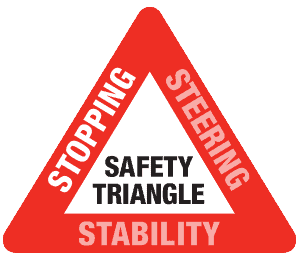SAFETY TRIANGLE
Shock absorbers are simply unseen components that never wear out and never need replacing, right? Wrong!
Shock absorbers are as important to your motoring safety as brakes and tyres. Shock absorbers keep your wheels in contact with the road; without them, your brakes and tyres simply can’t do their job. PLUS, they help you maintain control of your car AND ensure a comfortable ride by ‘dampening’ the bumps and vibrations of driving.
Simply put, a shock absorber is a metal cylinder filled with hydraulic fluid that has a piston and piston rod inside. By allowing the fluid to move through the cylinder at a pre-determined rate, a shock absorber restricts excessive suspension and wheel movement.
Heat is the natural enemy of a shock absorber. Driving and poor road conditions mean heat will naturally build up causing the hydraulic oil to become less viscous. Because a shock absorber has moving parts, a combination of heat, continuous movement, and oil leakage will eventually cause a shock absorber to lose its damping efficiency.
You may not notice the small changes that come about from worn shock absorbers because the degradation happens very slowly over time. You and your driving will naturally compensate for these changes. Most mechanics will not automatically check shock absorbers even though they should be checked every 20,000 km and especially after 80,000 km.
However, driving and braking issues are often related to worn shocks, not tyres or brakes. When having your car serviced, always ask your mechanic to check your shock absorbers.

Stopping
When travelling in a light passenger vehicle at 50 km/h, just one worn shock absorber can increase your stopping distance by up to 2 metres. That is in addition to the 30 metres a car travelling at 50 km/h needs to stop.
A bigger, heavier car needs more distance to stop. For example, a mid-size car travelling at 120 km/h requires 227 metres from observing a hazard and taking evasive action to coming to a standstill.
Worn shocks not only increase tyre wear and decrease fuel efficiency, but they increase the distance your car needs to stop. If you have noticed any braking issues, have your shock absorbers checked as soon as possible.

Steering
Worn shock absorbers can cause your tyres to lose contact with the road, dramatically affecting your ability to steer your car effectively.
If you notice that your car veers in a side wind, even if the wind isn’t particularly strong, or the vehicle swerves or dips when you brake, then have your shock absorbers checked as soon as possible.
Many people think uneven wear on their tyres is due to their vehicle needing a wheel alignment or that tyre pressure hasn’t been maintained. It’s more likely that the cause is worn shock absorbers, so ask your mechanic to check them.

Stability
Does it feel like you’re always driving over railroad tracks? That “shake, rattle ‘n’ roll” is caused by worn shock absorbers.
Because shock absorbers are designed to greatly minimize the impact of bumps and vibrations when driving, when you notice them it means your shocks need replacing.
If all roads were perfectly flat, your car wouldn’t need shock absorbers. Even subtle flaws in the road force pressure on the wheel causing it to move up and down. Without shock absorbers your wheels would lose contact with the road, momentarily, and slam back down again.
So apart from the comfort of driving and reducing the magnitude of vibrations, shock absorbers stabilize you car and increase safety. As an integral part of driving a safe car, have your shocks checked regularly.

What are the signs of worn shock absorbers?
There are several distinctive signs that your shock absorbers need to be checked. These include some of the pointers mentioned above. The best way to test the efficiency of your shock absorbers is a road test by a qualified mechanic. A mechanic will give you expert feedback to ascertain if your shock absorbers need replacing or repairing. To check some of the common signs that you have worn shock absorbers, click here to read more.

